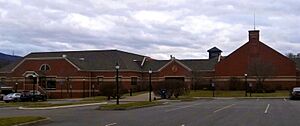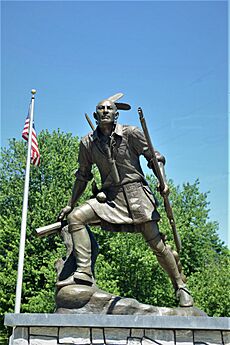Fishkill (town), New York facts for kids
Quick facts for kids
Fishkill, New York
|
||
|---|---|---|

Town hall
|
||
|
||

Location of Fishkill, New York
|
||
| Country | United States | |
| State | New York | |
| County | Dutchess | |
| Government | ||
| • Type | Town Council | |
| Area | ||
| • Total | 32.0 sq mi (82.9 km2) | |
| • Land | 27.3 sq mi (70.8 km2) | |
| • Water | 4.7 sq mi (12.1 km2) | |
| Elevation | 262 ft (80 m) | |
| Population
(2020)
|
||
| • Total | 24,226 | |
| • Density | 809/sq mi (312.2/km2) | |
| Time zone | UTC−5 (Eastern (EST)) | |
| • Summer (DST) | UTC−4 (EDT) | |
| ZIP Codes |
12524, 12527
|
|
| Area code(s) | 845 | |
| FIPS code | 36-25978 | |
| GNIS feature ID | 0978958 | |
Fishkill is a town in the southwestern part of Dutchess County, New York, United States. It's about 60 miles (97 km) north of New York City. In 2020, about 24,226 people lived there.
The name Fishkill comes from the Dutch words vis kill, which means "fish creek." The Native American people who lived here called the area Tioranda, meaning "The place where two waters meet." Fishkill is one of the nine original towns in Dutchess County. It is known for its rich history, especially from the American Revolutionary War, and its beautiful views of the Hudson Highlands.
Contents
History
Early Beginnings
In 1683, two merchants from New York City, Francis Rombouts and Gulian Verplanck, bought a large area of land in Dutchess County. They purchased about 85,000 acres (344 km²) from the Wappinger Native American group. This land was granted as the royal Rombout Patent in 1685.
The first European settlers were Catheryna Rombout Brett, Rombout's daughter, and her husband, Roger Brett. They built a mill where Fishkill Creek flows into the Hudson River.
Originally, the town of Fishkill was much larger. When it became an official town in 1788, it included areas that are now the City of Beacon, the Village of Fishkill, and the towns of Wappinger and East Fishkill. Over time, as new towns were formed, Fishkill became smaller, reaching its current size around 1913.
Some places in the town still have Native American names, like Matteawan Road and the hamlet of Wiccopee. Daniel Nimham, the last leader (sachem) of the Wappinger people, was born in the Wiccopee area in 1726.
Revolutionary War Role
Fishkill played a very important part in the American Revolutionary War. A large military camp, called the Fishkill Supply Depot, was set up here. It was a main supply center for the Continental Army. Signal fires were ready on nearby mountains to send messages.
The first copies of the New York State Constitution were printed in Fishkill in 1777. Mount Beacon, located in the town, got its name from the signal fires used during the war.
George Washington, the commander of the Continental Army, spent a lot of time in Fishkill. In 1778, a local silversmith named John Bailey made a special sword for Washington. Washington loved this sword and carried it throughout the rest of the war. Today, this sword is kept at the Smithsonian Institution.
Modern Times
Today, Fishkill has a varied economy. It includes tourism, healthcare, shops, restaurants, and many small businesses.
In 2021, the town ordered an eight-foot bronze statue of Daniel Nimham. This statue was created by sculptor Michael Keropian. It was placed at the Arrowhead intersection of NY-52 and NY-82 in May 2022. The statue was officially dedicated on June 11, 2022.
Government
The Town of Fishkill is led by a Town Supervisor and a Town Council. The Council has four members. Both the Supervisor and Council members are elected for four-year terms. They can serve a maximum of two terms.
As of 2024, the Town Supervisor is Ozzy Albra. The Town Council members are John Forman, Greg Totino, and Brian Wrye.
Fun Places to Visit
Fishkill has many places to visit, including several historic sites. Some popular spots are:
- Dutchess Stadium, home of the Hudson Valley Renegades baseball team.
- Mount Gulian, a historic house and garden.
- SplashDown Beach, a water and amusement park open in warmer months.
- Stony Kill Farm, a working farm and environmental education center.
- Van Wyck Homestead Museum, a historic home from the Revolutionary War era.
Where is Fishkill?
Fishkill covers about 32 square miles (82.9 km²). Most of this is land, but about 14.55% is water. The town's elevation changes a lot. It is at sea level along the Hudson River and goes up to 1,600 feet (488 meters) above sea level on South Beacon Mountain.
The southern border of Fishkill is shared with Putnam County. The western border is the Hudson River. Across the river are towns in Orange County. The city of Beacon is located within the town of Fishkill. To the north is the town of Wappinger, and to the east is East Fishkill.
The Fishkill Creek flows through the town from east to west and into the Hudson River. Since "Fishkill" means "fish creek" in Dutch, "Fishkill Creek" actually means "fish creek creek"!
Major roads like Interstate 84 and US 9 pass through Fishkill.
People of Fishkill
| Historical population | |||
|---|---|---|---|
| Census | Pop. | %± | |
| 1820 | 8,203 | — | |
| 1830 | 8,292 | 1.1% | |
| 1840 | 10,437 | 25.9% | |
| 1850 | 9,240 | −11.5% | |
| 1860 | 9,546 | 3.3% | |
| 1870 | 11,752 | 23.1% | |
| 1880 | 10,732 | −8.7% | |
| 1890 | 11,840 | 10.3% | |
| 1900 | 13,016 | 9.9% | |
| 1910 | 13,858 | 6.5% | |
| 1920 | 2,095 | −84.9% | |
| 1930 | 2,890 | 37.9% | |
| 1940 | 3,615 | 25.1% | |
| 1950 | 3,863 | 6.9% | |
| 1960 | 7,083 | 83.4% | |
| 1970 | 11,935 | 68.5% | |
| 1980 | 15,506 | 29.9% | |
| 1990 | 17,655 | 13.9% | |
| 2000 | 20,258 | 14.7% | |
| 2010 | 22,107 | 9.1% | |
| 2020 | 24,226 | 9.6% | |
| U.S. Decennial Census | |||
In 2020, the population of Fishkill was 24,226 people. The town is home to many different groups of people. About 18.3% of the population is under 18 years old. The median age in the town is 38 years.
Sports in Fishkill
Fishkill is home to the Hudson Valley Renegades. This is a minor league baseball team. They are connected with the New York Yankees. The Renegades play their games at Heritage Financial Park in the High-A East league.
Famous People from Fishkill

Many interesting people have lived in Fishkill:
- Elizabeth Allen – A famous actress and singer.
- Catheryna Rombout Brett – An important landowner and businesswoman in colonial times.
- Elijah A. Briggs – A soldier who received the Medal of Honor during the American Civil War.
- Robert Kanigher – A writer for DC Comics, known for characters like Wonder Woman and The Flash.
- Marquis de Lafayette – A French military leader who helped George Washington during the Revolutionary War. He recovered from an illness in Fishkill.
- Daniel Nimham – The last sachem (leader) of the Wappinger people and a veteran of the American Revolutionary War. He was born in Fishkill.
- Margaret Sanger – An activist who worked to educate people about family planning.
- Benjamin Strong Jr. – A banker who was a Governor of the Federal Reserve Bank of New York.
See also
 In Spanish: Fishkill para niños
In Spanish: Fishkill para niños
- Fishkill Correctional Facility
- Mount Gulian
- Stony Kill Farm
- Van Wyck Homestead Museum



